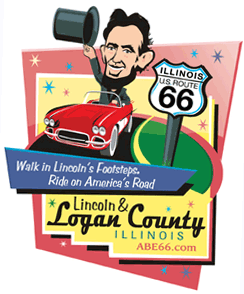 Rather than give up and move on, the residents took the disasters
and changed them into opportunities to rebuild their city, using
bricks and mortar. Rather than give up and move on, the residents took the disasters
and changed them into opportunities to rebuild their city, using
bricks and mortar.
The people of Atlanta had confidence in their community and in
each other. They believed that with the great train tracks of the
Alton-Chicago Railroad nestled within their boundaries, there was no
need to move on, but only to rebuild. With the trains came not only
the probability of growth, but the possibility of prosperity. And
so, collectively, they rebuilt their town and moved toward the
coming 20th century with tools in their hands and faith in their
hearts.
That same spirit of collective pride is again showing itself in
Atlanta as the 21st century begins to embed itself in local history.
The Downey Building at 110-112 SW Arch St. was rebuilt during the
great build of the 1860s in downtown Atlanta. Its predecessor, also
owned by businessman Alexander Downey, had been lost in one of the
fires that had ravaged the city.

The new brick building for years flourished as a grocery store,
but it housed many businesses over the years, including a bank, a
jeweler and the daily newspaper, The Atlanta Argus.
As the 19th century moved toward an end, the trains were a
blessing as well as a source of contention for Atlanta merchants.
Gone was the time-consuming need to traverse the dirt-patch roads
that had been rutted out of the landscape by countless
horse-and-buggy trips. A day's travel was now condensed into hours
of comfortable transportation on the great iron horses.
But for every train that stopped with wares for retailers'
shelves and unloaded its passengers to shop in Atlanta, as many
residents clambered aboard the trains to visit and shop in what was
now considered nearby: Bloomington and Springfield.
However, trains ran just so often and on a specific schedule.

The advent of the automobile gave Atlantans, as well as all of
America, the individual freedom to move about at their own pace and
on their own timetable.
The growth of the automobile from a novelty to a necessary means
of transportation demanded better roads as America became mobile.
An opportunity for more growth
In the mid- to late 1920s came the new and forever storied Route
66. Route 66 developed by using existing city streets and coupling
stretches of highways, creating the great singular trail from
Chicago to Los Angeles.
The new highway mixed with the winding city streets. It gave
Atlantans another opportunity, as well as a quandary, in maintaining
their economy. For every family that drove into town, another took
the highway to drive somewhere else.
In 1934 the Palms Grill Café was opened in the lower north
section of the Downey Building and flourished. Travelers as well as
residents embraced this new notion of eating out as the love affair
between mobility and eateries was born all across the great highway.
As time went on, America became enamored with quicker, faster
trips. Portions of the route running through the heart of the small
towns were circumnavigated as bigger highways were built. Businesses
created to fuel, feed and entertain the motorists found themselves
off the beaten track rather than on it.
[to top of second column] |

In time, Arch Street buildings began including "Old Route 66" as
part of their address. The end of an era and interim
In the late 1960s, the Palms Grill Café closed and the Downey
Building seemed headed for lesser days.
The building just a few years ago housed only a small machinist
shop operated by John Hawkins. When Hawkins died, the structure
might have stood silent, save for the Hawkins family donating the
building to the Atlanta Library.
The Atlanta Library and Museum board had been having their own
unique problems while the Downey Building quietly awaited a chance
to again become a proud part of the Atlanta community.
Lucille Pech has been the official curator of local history for
years. She has been gathering local memorabilia and collectibles, as
well as thousands of old photographs, since 1973.
The local museum has been housed in the basement of the Atlanta
Library but is landlocked by available space.
The museum also has prevented the library from expanding and
using the basement for additional library materials and books.

New life
The linkage of an empty historic structure, along with a need for
the museum to find a larger home, became obvious. Residents began
the great restoration of the Downey Building in 2006.
The huge endeavor consisted of literally taking the building down
brick by brick. When rebuilding it, modern structural and utility
needs were incorporated that would allow it to stand for another
century.
The southern lower level, the entire back of the building and the
entire second floor will be available for the museum to display its
artifacts.
New
Included in this new space will be a visitors center for Route 66
buffs to get their information and bearings. A historic resources
and genealogy section will be located on the second floor.
Renewed
The lower north side of the building will have a completely
authentic 1940s Palms Grill Café not only open for business, but
used as a much-needed source of income to maintain the museum and
help it grow over the years.
Sign of future
Motorists who drive down Arch Street in Atlanta can now see the
distinctive "Cafe" neon sign outside the Downey Building's restored
facade. It is hoped that by the end of 2008 the sign will be lit and
the doors to Atlanta's past will be open for business. The exact
date isn't as important as the fact that another portion of our
history and heritage has not only been saved, but will be shared
with future generations of Americans who travel America's Mother
Road.
[By MIKE FAK]
Readers can find more of Mike Fak's writing at
www.searchwarp.com
and www.problogs.com.
(A
Message From the Friends of the Atlanta Library and Museum)
|